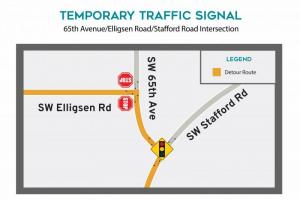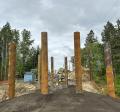Boeckman Road Corridor FAQ + Fact Sheet
What is the Boeckman Road Corridor Project?
As outlined in Wilsonville Transportation System Plan (TSP), the project is to modernize one of Wilsonville's three primary East/West roadways to support future development and improve public safety. This community improvement program includes four interrelated projects:
- Boeckman Dip Bridge Construction
- Boeckman Road Sewer Improvements
- Boeckman Road Street Improvements
- Canyon Road/Boeckman Road Intersection Improvements
Why is Noisy Pile Driving Necessary?
Residents should prepare for pile driving work beginning in mid to late May for approximately four weeks during daytime hours from 8 a.m. to 6 p.m., Monday through Friday.
Pile driving is a crucial part of building a strong foundation for the new bridge. During pile driving, vertical steel beams are driven deep into the ground. The new bridge is three-spans and requires a total of 18 steel “H”-piles and eight 36-inch diameter steel “pipe” piles for support. The H-piles will be driven approximately 80 feet into the ground and the pipe piles approximately 110 feet into the ground to achieve foundation loading requirements. Due to the heavy weight of the bridge and the soil strength, pile driving is necessary to create a deep foundation for the bridge. This work is very loud and repetitive and will cause vibrations in the area.
Vibration monitors are placed at key locations in the work area to ensure that vibrations do not exceed acceptable levels based on the limits of nearby structures. The noise from pile driving measures around 95 decibels at 100 feet away, or slightly louder than a truck or motorcycle at 25 feet. The noise at that volume is not be continuous; generally, it occurs when the hammer strikes the steel piles.
What are the main goals of the Boeckman Road Corridor Project?
The project's main goals are to increase safety and mobility for all users, and to link schools, trails, and residential communities by creating an environment that optimizes the roadway and provides safe passage for pedestrians, cyclists, and mass transit users. The project also expands road and sewer capacity to accommodate the community's evolving needs as Frog Pond neighborhoods develop.
Who is responsible for managing this project?
The City of Wilsonville is leading the project team. Consor (formerly Murraysmith) is performing Owner’s Representative services to assist the City in planning and executing the project following a progressive design-build (PDB).
How is the project being funded?
The majority of the project funding will be provided through the Year 2000 Urban Renewal district, Transportation and Wastewater System Development Charges (SDC), and Frog Pond Infrastructure Funds. SDC’s are one-time fees paid by developers at the time of development that cover the cost of transportation and wastewater facilities needed to serve growth.
In addition, Road Operating and Clackamas Vehicle Registration Fee funds and interfund loans to be repaid through a portion of Willamette Water Supply Program right-of-way lease payment will be used.
What is a progressive design-build?
Progressive design-build is a project delivery method that allows project principals to share input earlier in the design process, expediting portions of the project. This model enables the City staff, design team, and contractor(s) to collaborate and to be more nimble and innovative in coordinating the planning, design, and construction of four connected improvement projects. Using this approach, an integrated team can review the progress of design at different checkpoints and provide detailed cost estimates. Construction can start earlier, and the project can finish sooner.
What is the project’s timeline?
Select Progressive Design Build Team through an RFP process: Spring 2022
Project Design: Spring 2022 – Summer 2023
Construction: Summer 2023 - Substantially complete Summer 2025
What is the cost of the project?
The cost is estimated at approximately $36.8 million to complete the four inter-related projects, including the Boeckman dip bridge construction, Boeckman Road sewer improvements, Boeckman Road street improvements, and Canyon Road/Boeckman Road intersection improvements.
Where will construction occur? And how long will construction last?
Construction is to take place on SW Boeckman Road, between Canyon Creek Road and SW Stafford Road. Once bridge construction begins, in January 2024, it is expected to continue until Spring 2025, a period of a year or more. Thru traffic will not be permitted between Canyon Creek Road and Sherman Drive.
How will traffic be impacted during construction?
Completing these improvements will significantly impact traffic on Boeckman Road. The project necessitates the complete closure of Boeckman Rd. (between Canyon Creek Road and SW Sherman Drive) during bridge construction. Other lane closures and traffic control measures will be implemented as for other project elements. By undertaking four projects simultaneously and using a progressive design-build, the length of traffic impacts is being minimized. A priority of the project team is to reduce disruptions whenever possible; temporary signals, detours, and other traffic controls will be used to minimize delays and to protect those working in the construction zone. Additional details will be provided, when available, before construction begins.
How will the City keep the public up to date about the project and any traffic impacts?
The City is committed to keeping travelers and the broader community informed about the project and its impacts. Expect updates to the project web page, targeted mailings, fliers, and/or door hangers to those in/near the project area, social media posts on Facebook, Twitter and NextDoor, public open houses and articles in the Boones Ferry Messenger.
Why is the project necessary?
Boeckman Road was originally designed as a rural road; today it functions as a major east-west corridor. This project brings the road up to urban standards and provides upgrades that make travel safer and easier for drivers, cyclists, and pedestrians.
Upgrades to the existing steep, narrow, rural roadway to bring it to urban standards include:
- Construction of a bridge over Boeckman Creek
- Reducing the roadway slope to improve visibility for drivers, pedestrians, emergency responders and transit vehicles
- Improving bicycle and pedestrian facilities to make it easier to walk, run, and cycle
- Adding a roundabout at the intersection of Boeckman and Canyon Creek Roads
- Removing the large culvert to prepare for future fish passage and stream restoration
- Enhancing the creek’s natural resources and treating stormwater for improved water quality
How did the City come to the decision to build a bridge?
For years, the City’s Transportation System Plans has identified Boeckman Road’s narrow lanes, steep geometry, and site distance concerns at the Canyon Creek Road "Dip" as conditions that would need to be addressed to meet current standards, particularly as area traffic increased over time. There is a sidewalk on only one side and no bike lanes along this section of Boeckman Road, which poses undesirable conditions for motorists, pedestrians, and cyclists alike.
The City Council has prioritized reconstructing this section of Boeckman Road to improve safety for all users and restore the Boeckman Creek Corridor by replacing the old, deficient culvert with a bridge. City engineers and the Council studied other options -- such as simply widening the road and lengthening the existing culvert by raising the fill under the road and over the creek, or building a bridge that would cross over the old culvert. These options were rejected because a conditions assessment found the culvert to be deficient, nearing its life expectancy, and in need of replacement. State and Federal laws require fish passage if altering a culvert and mitigation of wetland and stream impacts when filling creek areas. To achieve these requirements, the City’s permitting specialist advised the City that permits for these options would be extremely difficult to obtain due to the magnitude of project impacts; something that could prevent the project from moving forward.
Engineers and the City Council agreed that the best option would be to replace the old culvert with a bridge, to restore a more natural habitat for fish and wildlife habitat. While supporting the value of natural resources, this option allowed the City to add bike lanes and pedestrian facilities, reduce the steep slope, and correct the sight distance problem and achieve a more desirable environmental outcome.
When will Boeckman Road be closed? Where will traffic detour?
The road closure is anticipated to occur in mid-January, but an exact date is not yet set. The closure is expected to last for about one year. The project team is making every effort to shorten the time frame. This closure is necessary to build the bridge quickly and efficiently with minimal negative impacts to animals and trees along Boeckman Creek. Detour routes will include Wilsonville Road and Stafford Road to Elligsen Road to Canyon Creek Road.
You can stay up to date on traffic impacts by signing up for text message alerts. Just text the word BOECKMAN to 866-935-0125. Standard messaging rates apply.
How will the already-crowded intersection of Stafford Rd and 65th handle additional traffic during the closure?

A temporary traffic signal has been installed at the intersection of Stafford Road and 65th Avenue to help mitigate increased traffic through the area while Boeckman Road is closed for construction.
Clackamas County owns and manages the road at this intersection. The city has been coordinating with the county to provide additional traffic controls during the Boeckman Road closure. Any long-term enhancements to the intersection will be determined by the county.
We appreciate the opportunity to answer your questions. We’ll continue sharing responses to frequently asked questions and providing project updates. If you have a question or topic you'd like to see us cover, click here to send us an email.
Where will construction vehicles park during construction?
Preliminary plans are for construction vehicles to park at a staging area on property owned by the City on the corner of SW Canyon and Boeckman Roads.
During what hours will construction take place?
Typically, Monday-Friday, 9 am to 3 pm. These may be adjusted seasonally. Occasional night and Saturday work may occur to speed completion of the project and to help shorten the closure of SW Boeckman Rd. Notifications will be provided before any night or Saturday work. No construction work is allowed on City-observed holidays.
What is being done to minimize noise and dust during construction?
Construction crews on the project will follow the City of Wilsonville dust and noise ordinances. During the dry weather conditions, dust will generally be controlled by covering exposed soils and spraying with water.
Why is my house vibrating?
During construction, compaction of the soil or gravel can result in vibrations that frequently cause smaller items to move or vibrate. This type of vibration complaint is typical during soil compaction and rarely results in any structural damage. Our contractor has switched means and methods of construction to limit this vibration, but not all of it can be eliminated. To date (~30 years), our experts have not seen any structural damage from compacting soil using these methods.
Will there be streetlights along the alignment?
Yes. Planning is underway for streetlights along SW Boeckman Rd. The exact placement of street lighting is under design.
Will there be lights under the bridge?
The design does not include lights under the bridge.
Will there be a trail through from Frog Pond to Canyon Creek Meadows?
Yes. A link to the regional trail system is part of the plan. Final designs are not complete for the trail at this time.





